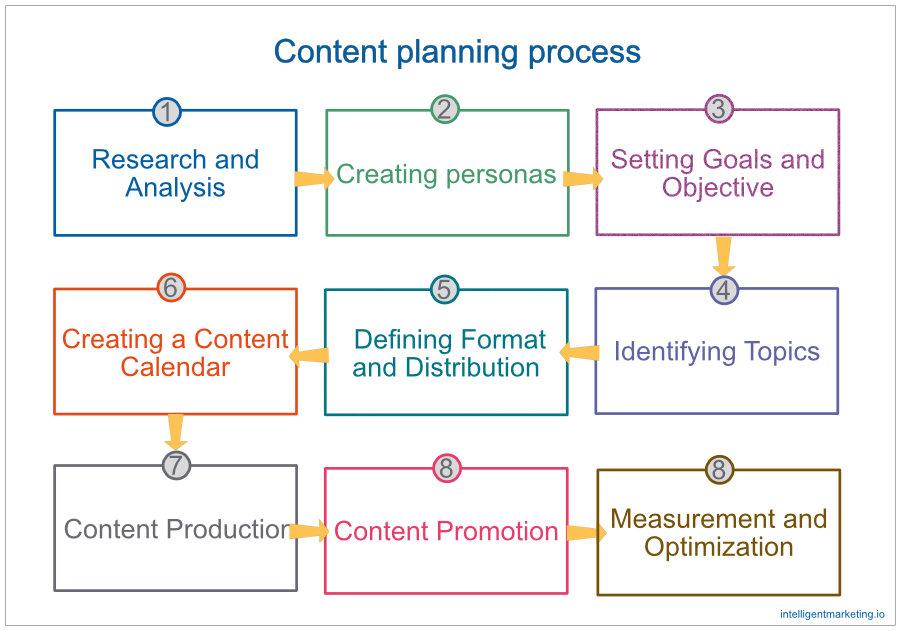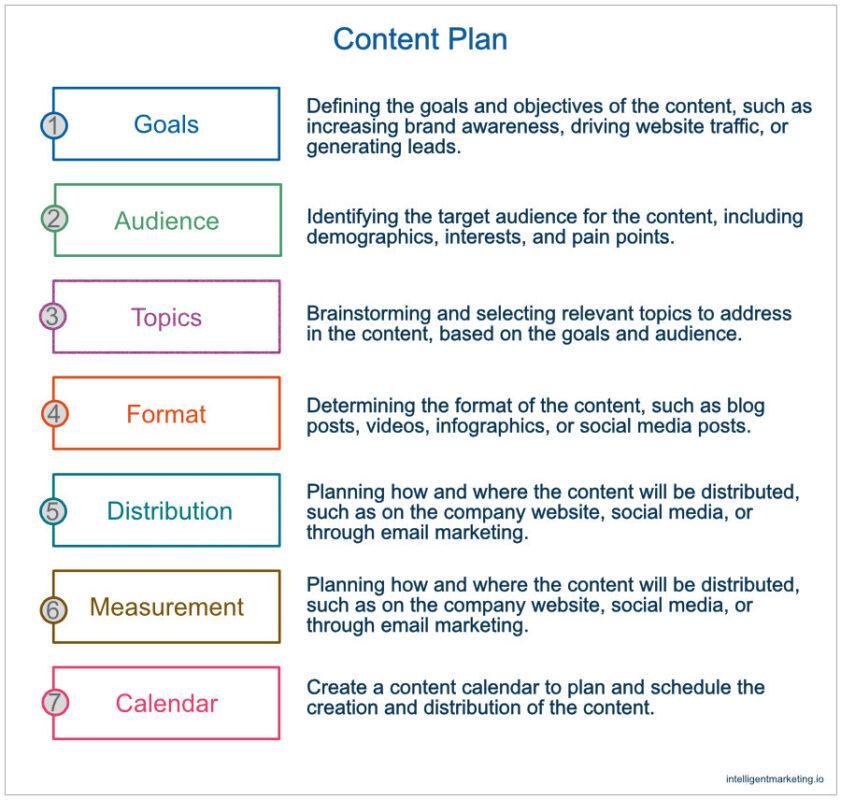Are you thinking about starting a content marketing campaign? Or maybe you’ve already started one, but it’s not going as well as you’d hoped. Either way, developing a strong content plan is essential to the success of your content campaign.
In this blog post, we’ll share some tips on how to create a content plan that actually works. We’ll cover everything from identifying your target audience to brainstorming ideas for creating engaging content. By the end of this post, you should have all the tools you need to develop a foolproof content plan. Let’s get started!
Content planning steps
The process of content planning typically involves the following steps:

Research and Analysis
Understanding the needs and interests of your target audience is essential to developing an effective content plan. Researching the target audience, industry trends, and competition can help you identify those needs and interests so that you can create content that resonates with them.
By researching these different aspects of your audience, you will be better equipped to develop a successful content plan that meets their needs. Through this research process, you’ll also gain valuable insights into how to best reach and engage with them. With a well-crafted content plan in place, you’ll be able to effectively capture their attention and drive results for your business.
Tips
Read customers’ e-mails, feedback, reviews, recommendations, and blogs that mention your product, service, or website, talk to your company’s Customer Service and Sales personnel, use web and social listening analytics, and conduct short interviewing of target customers.
Useful tools
- Web analytics: Google Analytics
- Social listening: Hootsuite, Buffer, Sprout Social, Google Alerts, Mention, Talkwalker, Brandwatch Analytics, Brand24, Awario, Falcon.io
- Survey: Google Forms
- Content curation: Pocket or Feedly
Creating personas
Creating personas is essential for any successful content marketing strategy. Personas are detailed profiles of your ideal customers that help you understand their needs, interests, and preferences in order to create more effective content. Persona is fictional.

They include information such as a picture, name, demographics, quotes from real people who fit the persona profile, values and beliefs they hold dear to them, stories they can relate to, and tasks they commonly perform.
By understanding your target audience’s behavior patterns through personas you will be able to create better-targeted content that resonates with them on an emotional level. With this valuable insight into customer behavior, you can craft more meaningful messaging and increase engagement with potential customers.
Setting Goals and Objectives
Setting goals and objectives is an important part of creating a content plan. The goals and objectives should be clearly defined and align with the overall mission of the company. The primary goal of the content plan is typically to increase brand awareness, engage with customers, or drive website traffic. Other common goals include generating leads, building customer loyalty, or increasing sales.
Tip: When creating a content plan, it is important to ensure that the goals and objectives are both specific and measurable. This means that they should include numerical values when possible, such as an exact number of website visits or conversions. Doing so allows you to track progress towards achieving the goals and make adjustments if needed. The best way to ensure that your goals and objectives are specific and measurable is to set SMART goals, which stand for Specific, Measurable, Attainable, Relevant, and Timely.

Identifying Topics
Once you’ve established your goals and objectives, it’s time to identify the topics that will be addressed in the content. Brainstorm topics that are relevant to the target audience, interesting to them, and align with the mission of the company.
When selecting topics, try to keep them timely and current, so that they will be relevant to the target audience.
Tips for Identifying Relevant Topics for Your Content Plan
- Brainstorm topics that align with the mission of your company and are relevant to your target audience.
- Research what competitors are doing and identify gaps in their content strategy.
- Read customer emails, feedback, reviews, recommendations, and blogs that mention your product or service.
- Speak with Customer Service or Sales personnel to understand customer needs.
- Analyse web analytics data to get an overview of user behavior on your website.
- Use social media listening tools to monitor conversations about your brand across different platforms.
- Conduct short interviews with target customers to ask them directly what they want from you as a business.
- Use Google Trends to identify which topics are popular now.
Useful tools
Google Trends
Social listening:
- Hootsuite,
- Buffer,
- Sprout Social,
- Google Alerts,
- Mention,
- Talkwalker,
- Brandwatch Analytics,
- Brand24,
- Awario,
- Falcon.io
Format and Distribution
After you’ve identified the topics, it’s time to decide on the format of the content.
Different types of content formats include:
- blog posts,
- white papers,
- videos,
- infographics,
- podcasts, and
- social media posts.
Think about which type of format will be the best fit for each topic, and what will engage your audience.
Once you’ve identified the format of the content, you should also consider where it will be distributed. This could include your website, email campaigns, social media channels, or even paid advertising campaigns.
Creating a Content Calendar
Next, create a content calendar that outlines when the content will be published and shared. This calendar should include the topic, format, and distribution channel for each piece of content. Creating a content calendar ensures that all of the content is being produced in a timely manner and allows you to track progress.
Useful tools
- Marketing campaign planning tool Monday.com
- Project planning tool: Trello, Asana
- Microsoft Teams Calendar
Production
Now comes the production stage, where you will actually create the content. This includes writing, editing, designing, and publishing the content. It is important to ensure that all of the content is produced according to the quality standards outlined in your content plan.
Tips: Creating content for your business should always be done with SEO, usability, and purpose in mind.
- Search engine optimization (SEO) is an important tool that can help ensure that your content is seen by the right people.
- Usability refers to how easily a user can understand and interact with your content – making sure it’s easy to read, navigate and find what they need quickly.
- Finally, knowing the purpose of each piece of content you create will help guide you in creating something valuable for readers or viewers.
By taking these three factors into account when creating content for your business, you can increase its reach and effectiveness.
Useful tools
Canva for visual creation like videos, infographics, presentations a.o.
Writing and keywords: Grammarly, AI writing Jasper, Headline Studio, SurferSeo, SemRush, Google Ads Keyword Planner.
Promotion
Once you’ve created and published the content, it’s time to promote it. Promote each piece of content through various channels, such as email campaigns, social media posts, and paid advertising. This will help to maximize its reach and engagement.
Useful tools
For e-mailing: Mailchimp, Constant Contact
For paid advertising: Meta for Business (Facebook Ads), Google Ads, LinkedIn Campaign Manager
Measuring and Optimizing
Finally, measure the performance and ROI of the content. Analyze the data to determine whether or not your goals have been met, and make any necessary adjustments in order to optimize results. This step is critical in ensuring that you are getting the most out of your content plan.
Useful tools
- Excel
- Google Sheets
- PowerBI
- Tableau
- Google Data Studio
This content planning process is an ongoing cycle, where the data from the measure and optimization step is used to improve the research and analysis, the definition of personas, setting goals and objectives, identifying topics and formats, creating the content calendar, and production steps.
Key elements of the content plan
A content plan typically includes several key elements:

Goals
One of the most important parts of creating a successful content plan is setting clear and measurable goals. This helps to ensure that the content produced is properly aligned with the mission and objectives of the company. Goals should include specific objectives, such as increasing brand awareness, driving website traffic, generating leads, building customer loyalty, or increasing sales. It’s important to ensure that the goals are realistic and achievable.
Target Audience
Another key element of a content plan is identifying the target audience. Knowing who you are targeting will help you create content that resonates with them, and determine which type of format and distribution channels would be most effective. It’s important to understand their needs, wants, interests, and pain points in order to create content that resonates with them.
Topics
The next step is to identifiy topics that will be addressed in the content. It’s important to select topics that are relevant and interesting
This helps to ensure that all of the efforts put into creating content are delivering real value and achieving desired results.
The topics should also be tailored to the target audience, so that they can relate to it and find it valuable.
Formats
Once the topics have been identified, it’s time to determine which type of format would be best suited for each topic. This includes things like articles, videos, infographics, podcasts, and social media posts. Think about which type of format will be the best fit for each topic, and what will be the most effective in terms of engagement and reach.
Distribution Channels
The next step is to identify which distribution channels will be used for each piece of content. This includes things like email, social media, search engines, blogs, forums, and more. Each channel should be chosen based on its ability to reach the target audience and deliver the desired results.
Measurement
Measuring the success of content is a critical step in creating an effective content plan. It allows you to track progress and make necessary adjustments to optimize results. To measure success, it’s important to define metrics that can be used to track performance, such as website traffic, engagement, and conversions. By tracking these metrics over time, you will be able to determine whether or not your goals are being met and make any necessary changes in order to maximize the impact of your content.
Calendar
A content calendar helps to ensure that all of the pieces are created and distributed in a timely manner while allowing you to track progress and make necessary adjustments along the way. With a well-crafted calendar in place, you can easily manage your content creation process and maximize the impact of your efforts.
Summary of Useful tools, and platforms for content planning
As a content marketer, having the right tools and platforms is essential for success. From analytics to scheduling tools, there are many options available that can help you create engaging content and measure its effectiveness.
Popular tools include social media management platforms such as Hootsuite and Sprout Social, content curation services like Pocket or Feedly, SEO tracking tools like Ahrefs or Moz Pro, project management software such as Trello or Asana, keyword research tools like SEMrush or Google Keyword Planner, email marketing solutions such as Mailchimp or Constant Contact, and analytics packages from providers like Google Analytics.
With so many choices available it’s important to choose the right ones for your specific needs in order to maximize efficiency and results.
Conclusion
Creating an effective content plan is essential for any business looking to produce engaging and valuable content that resonates with their target audience. By identifying clear goals, understanding the target audience, selecting relevant topics, choosing the right format, leveraging appropriate distribution channels, and creating
